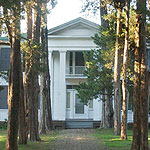Resources: Where to Learn More
The amount of Faulkner resources—essays, newsletters, websites, even movies—ain't trifling! In fact, Faulkner is the most studied author in the world, the subject of more books and articles than any other writer besides Shakespeare. So if reading three novels by Faulkner isn't enough for you, here's some extra credit.
 Center for Faulkner Studies
Center for Faulkner StudiesLocated on the campus of Southeast Missouri State University, the Center for Faulkner Studies supports educational, scholarly and public service projects related to William Faulkner, including a Visiting Japanese Scholar program and the Teaching Faulkner newsletter. The Center's renowned Brodsky Collection includes thousands of manuscript pages, letters and photographs.
 In 1930, after writing As I Lay Dying but before it was published, William Faulkner purchased an antebellum house in a sad state of disrepair and named it Rowan Oak. More about the house and grounds—who lived there, how it got its name and when you can visit.
In 1930, after writing As I Lay Dying but before it was published, William Faulkner purchased an antebellum house in a sad state of disrepair and named it Rowan Oak. More about the house and grounds—who lived there, how it got its name and when you can visit.
One Matchless Time: A Life of William Faulkner
Parini,who has taught Faulkner's work for 30 years, vividly brings to life Faulkner's complex fictional world in the context of his life. This magnificent biography is profound, thought-provoking, meticulously researched, elegantly composed and a tribute to the genius of its subject.
www.olemiss.edu/depts/english/ms-writers/dir/faulkner_william
www.lib.virginia.edu/small/collections/faulkner
https://www.english.ufl.edu/faulkner/
https://nobelprize.org/literature/laureates/1949/faulkner-speech.html
Ole Miss
Faulkner may have dropped out after three semesters, but he is still one of the University of Mississippi's most distinguished former students. The English Department offers a Faulkner biography.www.olemiss.edu/depts/english/ms-writers/dir/faulkner_william
University of Virginia
In 1957, Faulkner came to the University of Virginia as its first writer-in-residence. The university library holds a vast collection of Faulkner's manuscripts, first editions, personal papers and more.www.lib.virginia.edu/small/collections/faulkner
William Faulkner Society
The William Faulkner Society is dedicated to fostering the study of Faulkner and to promoting research, scholarship and criticism dealing with his writings and their place in literature. The Society sponsors panels, holds annual meetings and is affiliated with The Faulkner Journal. Membership is open to anyone interested in the writer and his work.https://www.english.ufl.edu/faulkner/
The Nobel Prize
Awarded the 1949 Nobel Prize for Literature, Faulkner didn't want to go to Stockholm for the award ceremony. Pressured by the U.S. State Department, the Swedish Ambassador to the United States and his own family, he finally gave in. Listen to his famous acceptance speech.https://nobelprize.org/literature/laureates/1949/faulkner-speech.html

While his immediate family fell on some hard times while William Faulkner was growing up, Faulkner's memory was filled with visits to his grandfather's home, "Big Place." In 1930, newly married to his childhood sweetheart, Estelle Oldham Franklin, and feeling confident about his writing, Faulkner purchased a stately antebellum house in Mississippi. A family friend of his father-in-law had given the newlyweds a fantastic deal—although the house was in desperate need of repair, for $6000 and a mortgage, Faulkner got his dream house and four acres of land.
The Faulkner's new home was known as the Shegog Place, after the old Irish Colonel who had built it in the mid-1800s, but that name didn't last long once the Faulkner's moved in. "In the evenings, Faulkner would read on the verandah, sipping whiskey. He was making his way systematically through Sir James Frazier's learned anthropological study, The Golden Bough, which had meant so much to [T.S.] Eliot as a background to The Waste Land. One night he came upon a passage about a rowan oak, indigenous to Scotland: not oak at all but a fruit tree with white flowers and red pomes. It symbolized peace and safety, and this struck him pleasantly; he now christened the new house as Rowanoak (or, fairly soon after, Rowan Oak)" (p. 156, One Matchless Timeby Jay Parini)
Faulkner and Estelle lived at Rowan Oak until his death in 1962. The house and grounds are now a museum operated by the University of Mississippi.
Guided tours are available:
10–4 Tuesday–Saturday
1–4 Sundays (Closed Mondays)
PH: 662-234-3284
Take a virtual tour: www.olemiss.edu/depts/u_museum/rowan_oak/interactive.html
Photo Credit: Rowan Oak © 2005 Bruce Newman.
Attend the annual Faulkner and Yoknapatawpha Conference this summer and go on more guided tours.
The Faulkner's new home was known as the Shegog Place, after the old Irish Colonel who had built it in the mid-1800s, but that name didn't last long once the Faulkner's moved in. "In the evenings, Faulkner would read on the verandah, sipping whiskey. He was making his way systematically through Sir James Frazier's learned anthropological study, The Golden Bough, which had meant so much to [T.S.] Eliot as a background to The Waste Land. One night he came upon a passage about a rowan oak, indigenous to Scotland: not oak at all but a fruit tree with white flowers and red pomes. It symbolized peace and safety, and this struck him pleasantly; he now christened the new house as Rowanoak (or, fairly soon after, Rowan Oak)" (p. 156, One Matchless Timeby Jay Parini)
Faulkner and Estelle lived at Rowan Oak until his death in 1962. The house and grounds are now a museum operated by the University of Mississippi.
Guided tours are available:
10–4 Tuesday–Saturday
1–4 Sundays (Closed Mondays)
PH: 662-234-3284
Take a virtual tour: www.olemiss.edu/depts/u_museum/rowan_oak/interactive.html
Photo Credit: Rowan Oak © 2005 Bruce Newman.
Attend the annual Faulkner and Yoknapatawpha Conference this summer and go on more guided tours.
Photo Credits: "The Square" (1968) by John McCrady, permission granted by Mr. and Mrs. William Lewis of Oxford, Mississippi; Rowan Oak © 2005 Bruce Newman. William Faulkner mural by Grant Lund, The Center for Faulkner Studies.



